

Image via Fred Espenak.
The star Deneb in the constellation Cygnus is one of the most distant stars you’ll ever see with your eye alone. That’s because it’s one of our Milky Way galaxy’s most luminous stars.
Deneb is somewhere around 2,600 light-years away, although astronomers still aren’t certain of the star’s exact distance. For now, just know that, when you gaze at this bright star, you’re gazing across thousands of light-years of space. That’s in contrast to most visible stars in our sky, located tens to hundreds of light-years away.
Want to see Deneb? You can gaze at this faraway star in the evening starting around around May, or late spring in the Northern Hemisphere. From this hemisphere, at this time of year (early August), Deneb shines rather high in the northeastern/eastern sky at nightfall, and appears at its highest point in the sky around midnight (1 a.m. daylight saving time). Like all stars, Deneb is found about one degree farther west at the same time each day, and climbs to its highest point about 4 minutes earlier per day, one-half hour earlier per week, or two hours earlier per month.
Deneb is part of several famous star patterns which overlap each other. It’s the brightest of the stars composing the constellation Cygnus the Swan, where it marks the Swan’s Tail. When you hear deneb in a star name, it always means tail.
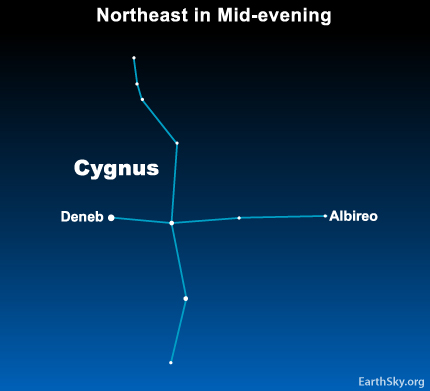
Deneb marks the Tail of Cynus the Swan … and the head of a crosslike pattern known as the Northern Cross.
Simultaneously, Deneb marks the head of an asterism (a readily recognizable grouping of stars that is not an official constellation), known as the Northern Cross.
Plus it is one of the three stars known as the Summer Triangle. The other two stars are Vega and Altair. Deneb is the northernmost and dimmest of the three Triangle stars, but its association with the other bright stars makes it easy to identify.
Deneb is circumpolar as seen from locations of about 45 degrees north latitude, roughly the northern tier of U.S. states. In other words, from the northern U.S. and similar latitudes, Deneb never sets but instead circles round and round the pole star. It cannot ever be seen south of about 45 degrees south latitude. That includes Antarctica, far southern Argentina and Chile, and perhaps the far southern tip of New Zealand’s South Island. Aside from that, just about anyone should have a chance to see Deneb at one time or another.
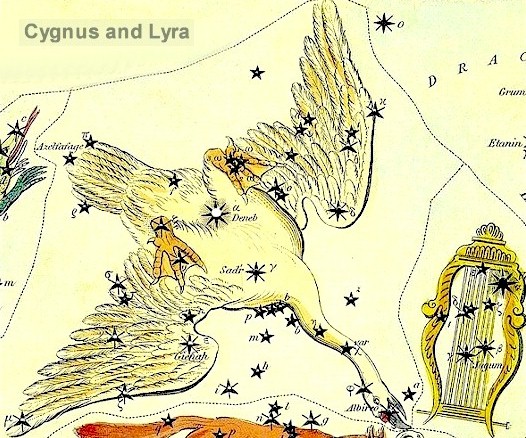
The constellation Cygnus the Swan. The bright star Deneb represents the Tail of Cygnus. Image via Constellation of Words.
Why don’t astronomers know the distance to Deneb exactly? Why are there varying estimates for this very luminous star’s distance?
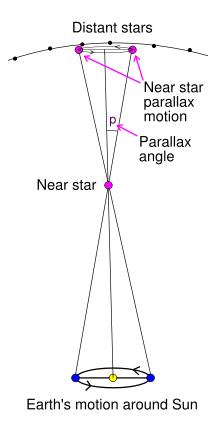
Astronomers can directly measure the distance to nearby stars using the parallax method. But Deneb is too far away for accurate parallax measurements from Earth’s surface.
For some decades, the most important distance measurement for Deneb is that from ESA’s Earth-orbiting Hipparcos satellite, which operated from 1989 to 1993. Hipparcos was the predecessor to Gaia. Both Hipparcos and Gaia gather astrometric data on the stars, measuring stars’ positions, motions and brightnesses so that astronomers back on Earth can later calculate a distance.
Early analyses of Hipparcos data indicated a distance of somewhere around 2,600 light-years for Deneb. Then, in 2009, a newer study – which used more powerful analysis techniques on Hipparcos data – gave a distance for Deneb that’s about half the widely accepted value, closer to 1,500 light-years. Today, that value – around 1,500 light-years – is the most widely accepted value for Deneb’s distance.
Why – with its recent large data release – hasn’t Gaia enabled astronomers to measure Deneb’s distance more precisely? Astronomer Anthony G.A. Brown of Leiden Observatory in the Netherlands – a member of the Gaia team – told us in May 2018:
Deneb is too bright to appear in Gaia’s second data release so we have no updated distance available. This holds for all stars brighter than about 2nd magnitude.
Gaia Project Scientist Timo Prusti added that a more accurate distance for Deneb might not be forthcoming in the Gaia data. The satellite just isn’t designed for that sort of work. He explained:
We have collected data also of the brightest stars. However, those fall out of the nominal dynamic range of Gaia and the data is heavily saturated. At a later stage, when the main mission data processing software has been finalized, we will have a look to those data, but, due to the saturation, it is not sure if we can get useful parallaxes for the brightest stars.
So, for now, the Hipparcos catalog is still the best source for Deneb’s distance and for the distance to other bright stars. Approximately 1,500 light-years for Deneb, for now.
And that’s impressive. In order for us to see a star shine so brightly in our sky, from this great distance away, the star must be very powerful. Deneb is thought to be one of the most luminous stars – one of the brightest stars, intrinsically – that we can see with the eye.
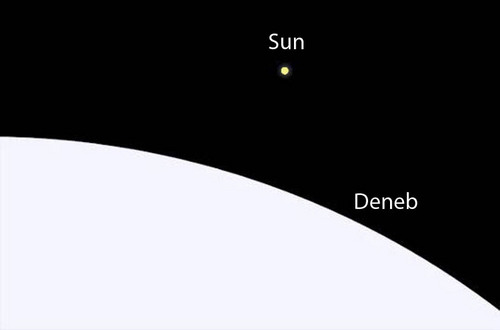
Deneb (bottom half of frame) is some 200 times bigger than our sun. Image via AstroBob.
The name Deneb derives from the Arabic Al Dhanab al Dajajah meaning Tail of the Hen. It obviously dates from an earlier incarnation of Cygnus not as a swan but as a chicken. Like many bright stars, Deneb has been called by a number of other names, but the oddest, according the Richard Hinckley Allen, who cites the Arabic name above, was Uropygium, meaning the posterior part of a bird’s body from which feathers grow, and oddly sometimes called the “Pope’s nose.”
In Chinese mythology Deneb is associated with the story of the Celestial Princess or the Weaver Girl. In this story a Girl (the star Vega) is separated from her beloved (a cowherd represented by the star Altair) by the Milky Way. Once a year, the girl and the cowherd are allowed to meet briefly when a large flock of magpies form a bridge across the starry river. Deneb represents the bridge.
Deneb’s position is RA: 20h 41m 26s, dec: +45° 16′ 49″.
Bottom line: Information on the star Deneb, plus how to see it in your sky.
from EarthSky https://ift.tt/2XrWqmI


Image via Fred Espenak.
The star Deneb in the constellation Cygnus is one of the most distant stars you’ll ever see with your eye alone. That’s because it’s one of our Milky Way galaxy’s most luminous stars.
Deneb is somewhere around 2,600 light-years away, although astronomers still aren’t certain of the star’s exact distance. For now, just know that, when you gaze at this bright star, you’re gazing across thousands of light-years of space. That’s in contrast to most visible stars in our sky, located tens to hundreds of light-years away.
Want to see Deneb? You can gaze at this faraway star in the evening starting around around May, or late spring in the Northern Hemisphere. From this hemisphere, at this time of year (early August), Deneb shines rather high in the northeastern/eastern sky at nightfall, and appears at its highest point in the sky around midnight (1 a.m. daylight saving time). Like all stars, Deneb is found about one degree farther west at the same time each day, and climbs to its highest point about 4 minutes earlier per day, one-half hour earlier per week, or two hours earlier per month.
Deneb is part of several famous star patterns which overlap each other. It’s the brightest of the stars composing the constellation Cygnus the Swan, where it marks the Swan’s Tail. When you hear deneb in a star name, it always means tail.

Deneb marks the Tail of Cynus the Swan … and the head of a crosslike pattern known as the Northern Cross.
Simultaneously, Deneb marks the head of an asterism (a readily recognizable grouping of stars that is not an official constellation), known as the Northern Cross.
Plus it is one of the three stars known as the Summer Triangle. The other two stars are Vega and Altair. Deneb is the northernmost and dimmest of the three Triangle stars, but its association with the other bright stars makes it easy to identify.
Deneb is circumpolar as seen from locations of about 45 degrees north latitude, roughly the northern tier of U.S. states. In other words, from the northern U.S. and similar latitudes, Deneb never sets but instead circles round and round the pole star. It cannot ever be seen south of about 45 degrees south latitude. That includes Antarctica, far southern Argentina and Chile, and perhaps the far southern tip of New Zealand’s South Island. Aside from that, just about anyone should have a chance to see Deneb at one time or another.

The constellation Cygnus the Swan. The bright star Deneb represents the Tail of Cygnus. Image via Constellation of Words.
Why don’t astronomers know the distance to Deneb exactly? Why are there varying estimates for this very luminous star’s distance?

Astronomers can directly measure the distance to nearby stars using the parallax method. But Deneb is too far away for accurate parallax measurements from Earth’s surface.
For some decades, the most important distance measurement for Deneb is that from ESA’s Earth-orbiting Hipparcos satellite, which operated from 1989 to 1993. Hipparcos was the predecessor to Gaia. Both Hipparcos and Gaia gather astrometric data on the stars, measuring stars’ positions, motions and brightnesses so that astronomers back on Earth can later calculate a distance.
Early analyses of Hipparcos data indicated a distance of somewhere around 2,600 light-years for Deneb. Then, in 2009, a newer study – which used more powerful analysis techniques on Hipparcos data – gave a distance for Deneb that’s about half the widely accepted value, closer to 1,500 light-years. Today, that value – around 1,500 light-years – is the most widely accepted value for Deneb’s distance.
Why – with its recent large data release – hasn’t Gaia enabled astronomers to measure Deneb’s distance more precisely? Astronomer Anthony G.A. Brown of Leiden Observatory in the Netherlands – a member of the Gaia team – told us in May 2018:
Deneb is too bright to appear in Gaia’s second data release so we have no updated distance available. This holds for all stars brighter than about 2nd magnitude.
Gaia Project Scientist Timo Prusti added that a more accurate distance for Deneb might not be forthcoming in the Gaia data. The satellite just isn’t designed for that sort of work. He explained:
We have collected data also of the brightest stars. However, those fall out of the nominal dynamic range of Gaia and the data is heavily saturated. At a later stage, when the main mission data processing software has been finalized, we will have a look to those data, but, due to the saturation, it is not sure if we can get useful parallaxes for the brightest stars.
So, for now, the Hipparcos catalog is still the best source for Deneb’s distance and for the distance to other bright stars. Approximately 1,500 light-years for Deneb, for now.
And that’s impressive. In order for us to see a star shine so brightly in our sky, from this great distance away, the star must be very powerful. Deneb is thought to be one of the most luminous stars – one of the brightest stars, intrinsically – that we can see with the eye.

Deneb (bottom half of frame) is some 200 times bigger than our sun. Image via AstroBob.
The name Deneb derives from the Arabic Al Dhanab al Dajajah meaning Tail of the Hen. It obviously dates from an earlier incarnation of Cygnus not as a swan but as a chicken. Like many bright stars, Deneb has been called by a number of other names, but the oddest, according the Richard Hinckley Allen, who cites the Arabic name above, was Uropygium, meaning the posterior part of a bird’s body from which feathers grow, and oddly sometimes called the “Pope’s nose.”
In Chinese mythology Deneb is associated with the story of the Celestial Princess or the Weaver Girl. In this story a Girl (the star Vega) is separated from her beloved (a cowherd represented by the star Altair) by the Milky Way. Once a year, the girl and the cowherd are allowed to meet briefly when a large flock of magpies form a bridge across the starry river. Deneb represents the bridge.
Deneb’s position is RA: 20h 41m 26s, dec: +45° 16′ 49″.
Bottom line: Information on the star Deneb, plus how to see it in your sky.
from EarthSky https://ift.tt/2XrWqmI

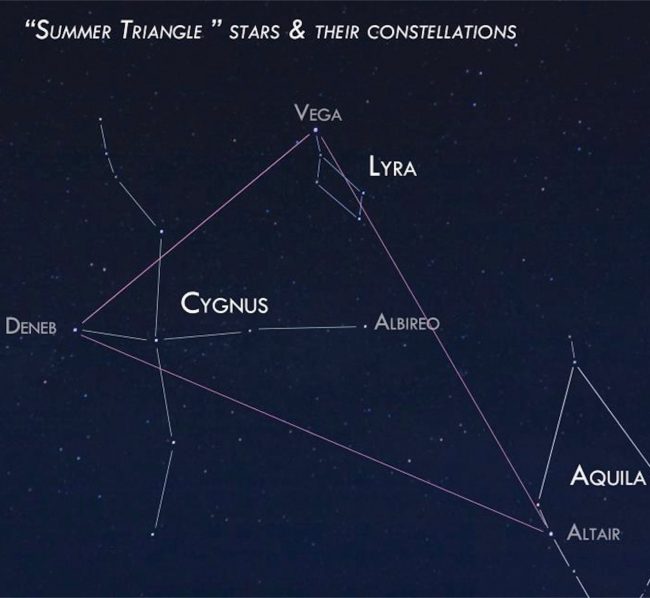
Aucun commentaire:
Enregistrer un commentaire